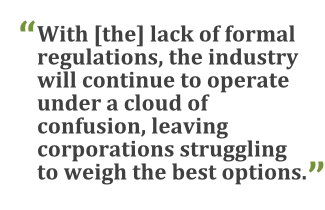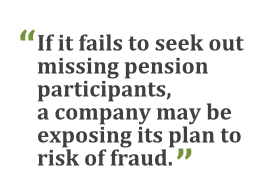If pension plan de-risking is a priority for your company in 2014,you should be aware of a potential pitfall. You may have researchedyour options and decided on the right program for your companyunder the assumption that communication channels will be reasonablyclear. Yet what you don't know about your past employees may have asubstantial and costly impact on your efforts.
|The quality of a company's data on retirement plan participantsmay not seem like a responsibility of the finance department, butthe issue presents a very real threat to de-risking strategies such as lump-sum distributions or annuitybuyouts.
|Even worse, when plan participants have gone “missing,” thecompany's out-of-date records create uncashed-check liabilities andincrease the risk of fraud. As scrutiny by the U.S. Department ofLabor grows, corporate finance and treasury teams can no longerignore the issue of missing participants in their pension and otherbenefits plans.
|Out of Sight, Not out of Mind
|Lifetime employees are few and far between in today's workplace.Younger workers are more likely to change jobs frequently, butolder professionals are also much more willing today than inprevious generations to change employers in order to advance theircareers. And companies can easily lose touch with workers who haveleft. A former employee may move from state to state, or mayrelocate internationally to accept a new position. Workers may notremember that they're owed pension or other retirement benefits, sothey may not think of updating their records with a former employerevery time they relocate.
|The problem can be exacerbated in companies that go throughmergers, sales, divestitures, or bankruptcy, particularly if thatevent results in a change in benefits providers or oversight.Meanwhile, marriage, death, name changes, and other milestoneevents in the lives of former employees can complicate the processof tracking down missing pension participants or theirbeneficiaries. The issue is more prevalent in industries withhigh turnover, such as retail, and young workers are especiallyvulnerable.
|The advent of auto-enrollment in defined-contribution plans hasled to a situation where even some current employees may notrealize they are enrolled in benefits programs. The Plan Sponsor Council of America (PSCA)has predicted that there will be more than 20 millionmissing-participant accounts in defined-contribution plans by theyear 2020.
|Many sponsors of pension and other benefits plans rely on theirrecordkeepers to determine the best methods for locating andcommunicating with missing participants, as well as for theday-to-day management of plan data. However, recordkeepers aresometimes unaware of how many missing participants a plan may have.RCP worked with one large pension plan sponsor that was offering alump-sum distribution to 29,000 of the company's retirees. Inadvance of the offering, the organization asked its recordkeeperhow accurate its data was. The recordkeeper believed it had correctcontact information for more than 90 percent of the retirees, butcloser analysis uncovered new addresses for 47 percent.
|Despite the significant challenges, it's imperative thatcompanies find, and periodically communicate with, any formeremployees who may still be due retirement and/or healthcarebenefits, either now or in the future. Losing contact with a formeremployee creates a number of challenges for a plan sponsor.
||
Caution: Confusion Ahead
|Companies are tasked with maintaining annual communications withparticipants about retirement and healthcare benefits. For example,plan sponsors must meet regulatory disclosure requirements aroundannual funding notices, summary annual reports, and plandescriptions. However, the industry lacks guidelines on thespecific steps necessary to comply when plan sponsors' attempts tocommunicate with missing participants are unsuccessful.
|The rules are no clearer for communication around pension plande-risking or other substantial changes to benefits. Anorganization is required to make a “good faith effort” to locateand notify participants of benefits they're due, yet there is nodefinitive rule clarifying which actions are sufficient to pass the“good faith” threshold. The stakes are high. Missing retirement orhealth-plan participants may prevent a company from successfullyimplementing programs that would improve benefits, or from changingthe way benefits are delivered. For example, in adefined-contribution plan termination, all assets must bedistributed for the termination to be complete—but the plan sponsorcannot finish distributing assets until every participant hascommunicated whether she wishes to take a cash payout or to rollover the funds.
Likewise, a company that wants to move forward with de-riskingits pension plan, through a lump-sum distribution or other means,must communicate with participants and elicit a response beforedispersing funds. Plan sponsors have a range of options availableto fulfill this fiduciary responsibility; they often select anapproach based on the advice of their Employee Retirement IncomeSecurity Act (ERISA) counsel, the company's tolerance for risk, andits risk culture. Whatever course of action it chooses, a company'sattempts to contact plan participants may fail if it doesn't haveaccurate data. At best, misdirected communications slow down theprocess; at worst, they may undermine the success of the program ifa substantial proportion of participants fail to respond.
|Although the ERISAAdvisory Council recently recommendedguidelines for de-risking, the U.S. Department of Labor did nottake any formal action, and there is no indication that specificguidelines will be adopted in the near future. With this lack offormal regulations, the industry will likely continue to operateunder a cloud of confusion, leaving corporations struggling toweigh the best options for resolution. Nevertheless, the de-riskingtrend is expected to continue, especially as plan funding levels have improved significantly.
|Risky Business
|Another issue, which further raises the stakes for plansponsors, is the uncashed-check liability that missing participantscan generate. When a company mails checks to plan participants,some may be returned, while others may simply not be cashed.Perhaps an individual is deceased and his beneficiary does not evenopen the envelope because she is not aware of the benefit. Undernew federalaccounting regulations, corporations must decide how to handleassets that are held outside of the plan, including uncashedchecks.
|Typically, when a check is returned or remains uncashed, thecompany will deposit the assets into a holding account. Uncashedchecks will remain on the company's balance sheet until the companylocates and communicates with the intended recipients. Over time,if an organization does not deal with the issue of missing planparticipants, this holding account may accrue a large balance, andit may eventually attract the attention of regulatory agencies.Uncashed checks also raise numerous other questions forcorporations, including:
- Where is the cash held?
- Who is receiving the interest?
- Are the funds still considered ERISA assets?
- Are taxes withheld?
- What options does the plan sponsor have if a participant failsto deposit the check, even after a successful search and subsequenteffort to communicate?
Moreover, when a company is mailing checks to the wrong address,it is creating security risks for plan participants, including thethreat of identity theft. And if it fails to seek out missingpension participants, a company may be exposing its plan to risk offraud. For example, if a participant is deceased, a relative orfriend might receive and cash benefit checks in the participant'sname. Recovery of the funds in this type of situation is extremelydifficult, and the effort often involves hefty legal fees.
|Weighing the Options
|For all of these reasons, many companies that are consideringpension de-risking or other changes to their benefits programs areturning their attention to finding missing plan participants. Theiroptions for doing so are shrinking. Some free and low-costsolutions that were once available to help locate missingparticipants, such as the IRS's letter-forwarding service, havedisappeared. For a small fee, the IRS used to search its databasefor missing and lost participants and forward communications. Itdiscontinued that service last year. The Social SecurityAdministration (SSA) offers a similar service, but it costs $35 perparticipant and can take up to 12 months. In addition, the SSAservice does not include a report providing participants' updatedaddresses, resulting in an incomplete audit trail.
Some plan sponsors attempt to find missing participants byresearching them one at a time using phone calls, public databases,and other methods. This approach can be time-consuming. Analternative is to work with a third-party raw-data search provider,which can speed up the process. In any such search, result accuracywill vary depending on how the search process accounts for possiblename variations, marriages and divorces, and other factors.Specialized firms can help plan sponsors set a course of actionbased on the extent of the missing-participant problem, theparticulars of the organization's benefits programs, thedemographics of its participant population, and the company's riskculture.
|Organizations that embark on an initiative designed to findmissing plan participants need to keep in mind that the goal isn'tjust locating participants, but also getting them to act. Plansponsors may want to work with a third party for assistance withcoding undeliverable mail, confirming current addresses to updateparticipant databases, communicating with participants in ways thatconvince them to take the required action, and providing audittrail reporting.
|Confirming—and, if necessary, improving—contact information forparticipants should be the first step in any pension plande-risking program. Data problems have the potential to underminede-risking, and the de-risking strategy may be crucial to theorganization's financial health. By resolving up front any issuesaround missing participants, a plan sponsor can avoid costly delaysand reduce risks as it moves forward.
|———————————-
| Mary Steigerwaltis the chief operating officer for Risk Compliance PerformanceSolutions (RCP), a risk management and compliance firm with afocus on retirement plan management, specializing in customizedrisk mitigation and compliance, communications, and outreachprograms. Mary's 25-plus years of experience as a practitioner andsolutions provider gives her a comprehensive perspective onretirement plan management.
Mary Steigerwaltis the chief operating officer for Risk Compliance PerformanceSolutions (RCP), a risk management and compliance firm with afocus on retirement plan management, specializing in customizedrisk mitigation and compliance, communications, and outreachprograms. Mary's 25-plus years of experience as a practitioner andsolutions provider gives her a comprehensive perspective onretirement plan management.
Complete your profile to continue reading and get FREE access to Treasury & Risk, part of your ALM digital membership.
Your access to unlimited Treasury & Risk content isn’t changing.
Once you are an ALM digital member, you’ll receive:
- Critical Treasury & Risk information including in-depth analysis of treasury and finance best practices, case studies with corporate innovators, informative newsletters, educational webcasts and videos, and resources from industry leaders.
- Exclusive discounts on ALM and Treasury & Risk events.
- Access to other award-winning ALM websites including PropertyCasualty360.com and Law.com.
*May exclude premium content
Already have an account? Sign In
© 2024 ALM Global, LLC, All Rights Reserved. Request academic re-use from www.copyright.com. All other uses, submit a request to [email protected]. For more information visit Asset & Logo Licensing.







